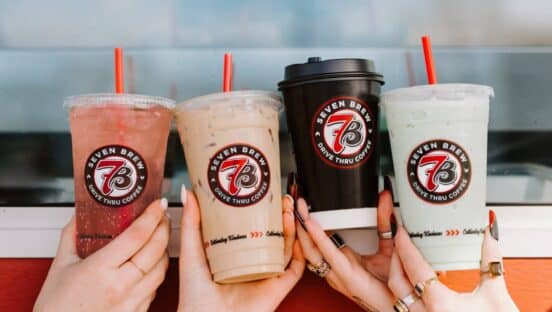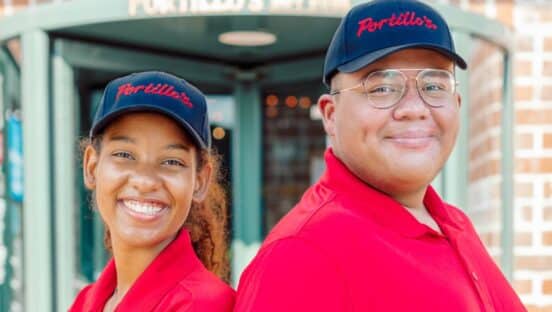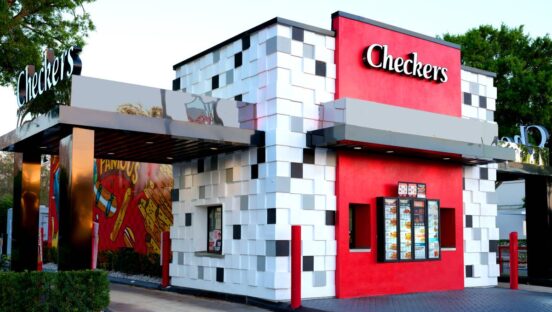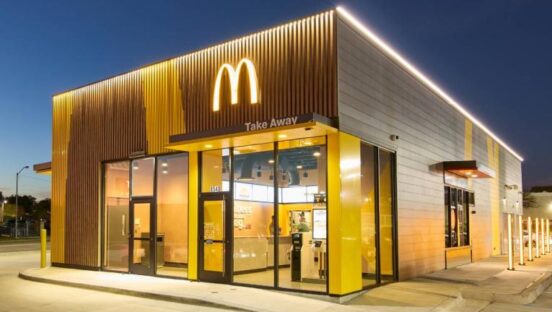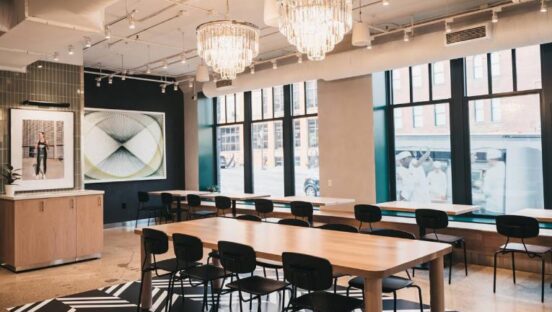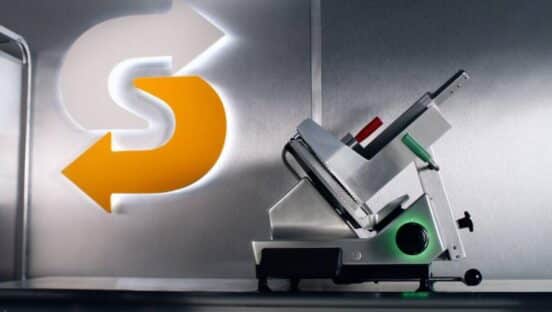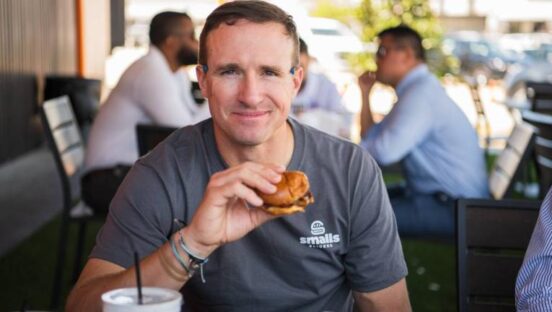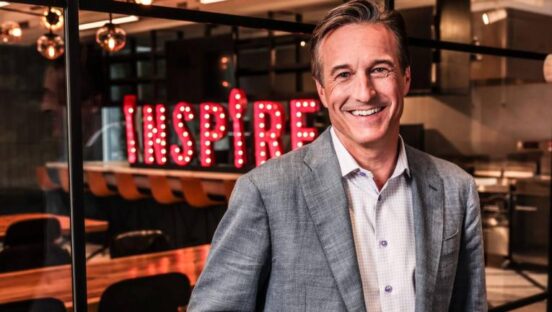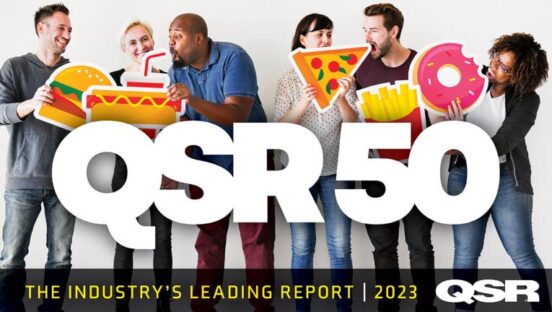Competition has become even fiercer among the top 50 brands in limited service, with this year’s QSR 50 report resembling a game of Chutes and Ladders. Some brands (looking at you, Taco Bell and Chick-fil-A) climbed above formidable opponents, while others slid a few levels due to lackluster sales and any variety of setbacks.
Each brand travels its own road toward success, but big-picture patterns still emerge. For one, the top performers didn’t just welcome digital advancements, but rather they were instrumental in creating new solutions. Other winning trends included a willingness to experiment with bolder flavors without straying too far from core cuisines, as well as a sharp ear for customer trends.
It all came together to create another exciting and all-around unpredictable year in the limited-service restaurant industry.
01
McDonald’s
It’s steady as she goes for the Golden Arches, which remains far and away the No. 1 fast-food chain. Goals set under the leadership of CEO Steve Easterbrook continue to bear fruit; system-wide revenues have gained about $1 billion each year under his direction, while same-store sales continue to make modest growth. All the while, McDonald’s is continuing in its mission to sell corporate stores back to franchisees.
Beyond modest financial gains, McDonald’s has made industry headlines for its recent acquisition of personalization pioneer Dynamic Yield. It’s a marriage that could wholly redefine the drive-thru experience, as the software uses decision technology, guest data, and other factors (weather, calendar events, etc.) to tailor promotions and highlight menu items.
McDonald’s also touted its international savvy this past year. In June, it unveiled a new line of Worldwide Favorites, which featured hit items from Spain, the Netherlands, Australia, and Canada. The brand even accepted foreign currency for a day to kick off the limited-time offer.
02
Starbucks
A poll by mattress firm Amerisleep found that American millennials spend an eye-popping $2,000 on coffee each year. Perhaps that statistic offers some explanation as to the astronomical figures that Starbucks continues to post. The coffee giant has spent the past year driving expansion in its Asian markets and honing its environmental initiatives with investments in solar and wind farms. On the digital side, Starbucks Delivers via Uber Eats is rolling out in more cities, while the company flirts with cryptocurrency following an equity cut from Bakkt, a digital asset ecosystem.
03
Subway
Things aren’t terrible at Subway, but they’re certainly not great. The brand shuttered more than 1,000 domestic stores last year, while revenues dropped by nearly half a billion dollars.
Still, Subway is in it for the long haul. The Fresh Forward design is probably the most ambitious—and costly—program on the books, but early indicators are promising. On average, retrofitted stores are pulling in 11 percent higher gross profits while welcoming 8 percent more foot traffic than non–Fresh Forward units. Playing the culinary counterpoint to design is Subway’s FreshNOW program, which further champions menu customization through new sauces, flavors, and beverages.
04
Taco Bell
Even without former CEO Brian Niccol at the helm, the numbers hummed along nicely for Taco Bell, which has now enjoyed seven consecutive years of growth. In fact, it has now surpassed all burger chains save for McDonald’s to claim its position as the fourth-largest quick serve in the country. Like its core customer base of teens and young adults, the category leader seems indefatigable in its effort to rethink what a fast-food brand can do. It turned the mundane job-application process into a celebration with its Hiring Parties, wherein prospective applicants gathered for free food, games, and on-the-spot job interviews. It continued making forays into fashion, first with a Tipsy Elves collaboration around
the holidays and later with sauce packet–themed bathing suits and pool floats. With lightning speed, it wholeheartedly embraced and promoted its extensive vegetarian menu options, beating other major
quick serves to the punch. Oh, and did we mention Taco Bell opened its own hotel and resort in Palm Springs, California, this summer?
05
Chick-fil-A
We all knew this day was coming. Chick-fil-A has officially graduated into the $10 billion sales club and, in doing so, leapfrogged two spots in the QSR 50. Unlike most major chains, Chick-fil-A has never sought to reinvent the wheel, but it is consistently greasing that wheel. On the F&B side, it’s started testing new spicy menu items while introducing seasonal offerings like the Frosted Key Lime.
But where Chick-fil-A is really challenging the status quo is in its operations. Last fall, the brand began testing a new store prototype, one that focused on catering and delivery. Instead of ample dining space, these locations will essentially serve as commissaries for off-premises orders. It’s also one of the first restaurants to embrace artificial intelligence. But instead of using AI in a customer-facing capacity, Chick-fil-A has developed custom technology to monitor social media and identify potential outbreaks of food-borne illnesses.
06
Wendy’s
It looks like the Freckled Lady is finding her footing again. System-wide sales returned to their 2016 levels after having dipped by more than half a billion dollars the previous year. Revenues weren’t the only thing making a triumphant return at the brand; this summer brought with it a few other throwbacks, including its Berry Burst Chicken Salad and 50-Cent Frosty deal. In terms of innovation, the Made to Crave menu first ushered in three ultra-indulgent cheeseburgers, and more recently, a trio of chicken sandwiches.
Digital is proving a source of both pain and hope. In February, Wendy’s finally reached a settlement in a series of class-action lawsuits stemming from massive security breaches in 2015 and 2016. Around the same time the company announced it would invest $25 million (roughly the same amount it reportedly paid in the lawsuit settlements) to bolster its digital prowess through such means as improved mobile ordering and enhanced customer analytics.
07
Burger King
The King faced something of a coup this past year, as it fell three spots on the QSR 50, making it one of only two brands on the list to lose so much ground. System-wide sales were more than $100 million lower despite closing the year with 100 more units. In January, a shake-up at parent company Restaurant Brands International (RBI) led CEO and CFO Daniel Schwartz to transition to co-chairman of the company’s board of directors, as Burger King veteran Jose Cil took the chief executive reins. Since then, the chain has busied itself with a number of initiatives across myriad platforms. Its Super Bowl ad featuring Andy Warhol eating a Whopper sparked conversation and reflected an aggressive new marketing strategy. The brand is also leaning into promotions, like the Whopper Detour and BK Café coffee subscription, to boost revenues and entice customers to download the BK app. In May, RBI announced plans to scale its portfolio of three brands—Burger King, Popeyes, and Tim Hortons—from 26,000 units to 40,000 within the next decade. As the group’s marquee brand, Burger King has a conquest ahead of it.
08
Dunkin’
Dunkin’ could be well on its way to conquering every corner of America. Last fall the chain dropped “Donuts” from its moniker to mark its new identity as a brand that goes far beyond one indulgent specialty. To that end, Dunkin’ has souped up its savory options, including its Power Breakfast Sandwich and egg-based Dunkin’ Bowls. On the beverage side, the chain has leaned into zany flavors—its multi-hued Cosmic COOLATTAs call to mind a certain unicorn drink from a competitor—while also dabbling in alcoholic libations thanks to a collaboration with Harpoon Brewery.
These seemingly playful offerings belie a relentless shift within the brand. The introduction of espresso, cold-brew on tap, and other craft beverages shows that Dunkin’ is ready to challenge not just the likes of Starbucks, but indie coffeehouses as well.
09
Domino’s
Domino’s boasts both stamina and speed as it continues to deliver on more than just its signature product. As of 2017, it accounted for 29.3 percent of pizza delivery market share—up from 21.9 percent in 2011—and it’s a percentage that will likely keep growing. The No. 1 pizza chain is also the fast-food leader in all things digital. New advances from the past year include its Points for Pie program, which rewarded guests for ordering pizza, even if it was from a competitor; in-car ordering capability beginning with select 2019 car models; and GPS driver tracking, which is in the pilot phase. Domino’s has also maintained its balance between discounts and value, from half-off pizza deals during March Madness to a $5.99 two-topping carry-out deal in May.
10
Panera Bread
The first fast casual to break into the QSR 50’s top 10 has three years later regained its standing among the limited-service industry’s most elite—and it’s an honor rightfully earned. In April, Panera unveiled a special You Mix 2 menu that was crowdsourced from guest hacks (think: Mac & Cheese combined with Creamy Tomato Soup to create the Mac-Tomato Medley). Not only did the special appeal to secret menu lovers, but it also featured an augmented reality tie-in to Snapchat. Given that three-quarters of its sales take place after 11 a.m., Panera is in hot pursuit of better-breakfast business; in April, it launched three new breakfast wraps, just a year after it introduced breakfast sandwiches. That same month, Niren Chaudhary left fellow JAB Holdings brand Krispy Kreme to become Panera’s new CEO. His appointment was just the latest in multiple C-suite additions, including a new chief people officer and chief restaurant operations officer.
11
Pizza Hut
It wasn’t a remarkable year for Pizza Hut in terms of profits or expansion, but the Yum! Brand did work hard to capitalize on its status as the official pizza of the NFL. It stepped into that role in February 2018, but it was too late in the proverbial game to make a splash. This past season, Pizza Hut kicked it into high gear with a multi-pronged campaign that included giveaways like Super Bowl tickets and a new Game Plan function within its loyalty app to remind fans of upcoming games and prompt them to make a pizza order. The chain also expanded its beer delivery to 300 new locations.
On the tech side, Pizza Hut introduced the PIE Pro last fall. The system pushes the bounds of delivery freshness through robotics; pre-assembled pizza orders are cooked and sliced within the bed of a Toyota Tundra pickup. More recently, it teamed up with FedEx to test its SameDay Bot for delivery.
12
Chipotle
Brian Niccol hit the ground running when he took over the beleaguered fast casual in early 2018. The brand did about $400 million more in sales than it had the previous year, while average unit volume bumped up to $2 million. That’s still short of the AUV it was pulling three years ago; Chipotle may never return to its high pedestal, but under Niccol’s direction it’s poised to be a competitive player by embracing digital and deals while still sticking to its high-quality fare. Over the past year it introduced Plant-Powered Lifestyle Bowls, sold produce boxes for a limited time, and announced a goal to divert half of its restaurant waste from landfills by 2020. An even stronger move? Chipotle at last launched its rewards program in March, meaning its base of 3 million digital members is almost certain to grow exponentially in the coming months.
13
Sonic Drive-In
Sonic Drive-In may be a value-oriented brand, but last fall, Inspire Brands (parent of Arby’s and Buffalo Wild Wings, among others) ponied up $2.3 billion to bring it into the fold. The acquisition hasn’t altered the brand’s identity; menu innovation is still its bread and butter, with the past year welcoming a number of new items. The Hearty Chili Bowl arrived in time for winter, while the BBLT (that extra “B” means more bacon) proved that the brand wasn’t inching away from meats just because it had embraced the blended-burger movement. Sonic also became the first major chain to offer a perennial carnival snack—deep-fried Oreos—and experiment with Red Bull in its signature Slushes.
14
KFC
Sales dipped ever so slightly for the second year in a row at the leading bone-in chicken chain, while average unit volume enjoyed an incremental uptick. KFC continued its Colonel antics, even going so far as to give one family scholarship funds for naming their child Harland. The brand brought back popular LTOs, including KFC Famous Bowls and Chicken & Waffles, and sold Cinnabon Dessert Biscuits for a limited time. Despite a relatively muted year, KFC could be gearing up for a comeback; the first quarter of the new year marked its best growth in three years.
15
Arby’s
It should come as no surprise that Arby’s is moving up. The Inspire Brands cornerstone came in $200 million higher in sales over last year, with average unit volume also getting a nudge up. The parent company is betting that its pooled resources, now spanning four chains—Arby’s, Sonic, Rusty Taco, and Buffalo Wild Wings—will make each brand appeal to would-be franchisees. On the menu side, Arby’s has stayed steadfast to its meat obsession. In May, Arby’s released an official statement emphasizing that it would never offer plant-based meat alternatives following rumors that the brand was in talks with Impossible Foods.
16
Little Caesars
Trimming the fat could help Little Caesars take on the top three pizza players instead of hovering, like Papa John’s, between major and regional chains. Digital continues to be the brand’s Achilles heel, but it has bested the competition with its Pizza Portal, which keeps customers’ orders hot in an on-site vending machine until they come to retrieve it with a QR code.
17
Dairy Queen
Sales performed well enough at Dairy Queen, but it was the second year in a row that DQ shuttered a double-digit number of stores. But growth could be around the corner. A quartet of new franchising incentives debuted earlier this year and could help spark growth among new and existing operators. Regardless, the brand needn’t fret; after all, it has the backing of Berkshire Hathaway, with owner Warren Buffett even working a Dairy Queen shift alongside his buddy Bill Gates in June.
18
Jack in the Box
“Fraught” may be the only way to describe the past year for Jack in the Box. The California-based brand was unable to find a private-equity buyer after flirting with a few suitors last winter. Around that same time, disgruntled franchisees banded together to file a lawsuit against the brand, citing breach of contract over the company’s financial restructuring, and have since called for CEO Lenny Comma to step down. While it’s near impossible to ignore such tensions, the brand is still busy doubling down on drive thru, which accounts for 70 percent of its business.
19
Panda Express
The leading Asian category purveyor isn’t one for splashy news or in-your-face promotions. Instead, Panda Express modestly churns out stores (up 93 this year) and sales (a nearly $300 million lift) to yield impressive results and upward mobility. This is probably due to its predilection for corporate growth; more than 90 percent of locations are company-owned, and founders Andrew and Peggy Cherng are still running the show decades later. But another piece of Panda’s success is its seemingly universal appeal to American palates.
20
Popeyes
Parent company RBI aims to become one of the largest restaurant groups in the world, and Popeyes may be the best growth vehicle for that goal. Over the past few years, it’s added the most new units to its system among RBI brands, while sister concept Tim Hortons has closed many and Burger King searches for white space. Despite these aggressive expansion plans, Popeyes still found time for irreverent ideas; namely, a 12-hour drive-thru competition and an “Emotional Support Chicken” carry-out box at its location in the Philadelphia International Airport.
21
Papa John’s
Founder and former CEO John Schnatter’s controversial comments and actions finally caught up with Papa John’s bottom line in 2018, just as things were starting to quiet down in the media. Nevertheless, there are signs for optimism. Starboard Value LP injected $200 million into the floundering brand while installing its own executive, Jeff Smith, as CEO. As Schnatter’s stake in the company dwindles, brand leaders are superimposing Shaquille O’Neal as the new face of Papa John’s; the former NBA star and sports analyst now serves as a board member, investor, and brand ambassador. These changes are already translating to dollars and cents, with the company posting quarterly sales gains as of late.
22
Whataburger
Texas-based Whataburger never garners the national adoration of competitors like Shake Shack and In-N-Out, but that does little to squelch fan fervor—and the numbers prove it. Although the regional favorite only added a handful of stores, it saw a nice uptick in both system-wide sales and average unit volume. Expansion could be more aggressive in the coming years, as the brand recently retained Morgan Stanley to explore potential investment options.
23
Jimmy John’s
As its limited-service peers hop on the third-party delivery bandwagon, Jimmy John’s is staying the course with its commitment to “freaky fast” delivery made by restaurant employees, not an outside provider. The sandwich chain even issued a public announcement stating as much, as well as a new campaign that delves into its Sandwich Delivery Zones.
24
Hardee’s
The larger half of CKE Restaurants didn’t grow sales last year, but it did make further progress in defining itself. Since the parent group split up Hardee’s and Carl’s Jr., the two have strived to differentiate themselves through marketing, menu offerings, and expansion strategies. For Hardee’s, that meant leaning into its Southern roots, which it did by testing new menu items like the Catfish Sandwich and Sweet & Spicy Chicken Biscuit, while bringing back favorites including the Grilled Cheese Bacon Thickburger.
25
Zaxby’s
Momentum has stalled for the Georgia-based chicken provider, and now Zaxby’s has found itself caught up in a food-safety nightmare, with multiple cases of Hepatitis A reported in its restaurants. Between December and June, there were three separate reports of employees with the virus working at stores in Kentucky, Florida, and South Carolina. The ongoing incidents overshadowed its “Men in Black International” campaign featuring a Blackened Blue Zalad, Cosmic Chocolate Cookie, and Mello Yello Unidentified Fizzy Object.
26
Five Guys
What Five Guys lacks in flash it more than makes up for with a seemingly evergreen playbook for good business in the better-burger space. The brand added about $200 million in sales while also kicking up AUV. It’s also betting its straightforward menu of simple, quality burgers and fries will appeal to burgeoning Asian markets. In addition to other overseas openings, Five Guys debuted a unit in Hong Kong last winter, followed by a store in Beijing this summer. The former reportedly enjoyed such hype as to have a 150-foot line wrapping around the building.
27
Culver’s
The Wisconsin-based chain isn’t abandoning its signature ButterBurgers and frozen custard, but it is carving out space on the menu to experiment with new LTOs. Recent offerings include a Spinach Artichoke BLT Crispy Chicken Sandwich and Strawberry Fields Salad, as well as the return last fall of its Oktoberfest-inspired Pretzel Haus Pub Burger to much fanfare.
28
Carl’s Jr.
The other side of CKE Restaurants embraced its West Coast vibes in 2018 with a vegan, Beyond Meat take on its iconic Carl’s Jr. Famous Star Burger and a test-run of a CBD Burger in Denver (served on 4/20, naturally). More indulgent but still regionally inspired LTOs included a Triple Western Bacon Cheeseburger and Western Fries, both of which used a brand-new Western seasoning.
29
Bojangles’
It’s been a busy year for Bojangles’. Just three years after the regional biscuit chain made its stock-market debut, two private-equity firms jointly purchased it for $593.7 million, returning the brand to private status. Since then, Bojangles’ has ushered in a coterie of C-suiters, including former McDonald’s execs Jose Armario and Brian Unger as CEO and COO, respectively; Panera alum Kenneth Koziol; and Jackie Woodward from Krispy Kreme.
30
Wingstop
Wingstop is working hard to give the pizza chains a run for their money, both in terms of daypart competition and digital savvy. Digital transactions bring in about $5 more per order, and thanks to what CEO Charlie Morrison describes as a “slick user interface,” such orders now comprise 27.6 percent of domestic sales. At the same time, Wingstop is popping up with new locations across the country—more than 200 last year—and rolling out delivery service across its kingdom.
31
Raising Cane’s
Raising Cane’s may lag behind more established boneless chicken competitors, but it’s quickly gaining ground. Based in Baton Rouge, Louisiana, the chain spent the last year opening locations in Kentucky, Arkansas, Ohio, Iowa, Texas, Colorado, and even Alaska—a state neither Chick-fil-A nor Zaxby’s has yet reached. Raising Cane’s also teamed up with Chuck Norris to fundraise for his nonprofit, the Kickstart Kids organization.
32
Jersey Mike’s
The sandwich brand with arguably the most philanthropic reputation broke the $1 billion sales mark this past year and raised a record-breaking $7.3 million during its Month of Giving in March. Now Jersey Mike’s has its sights trained on another mile marker: hitting 2,000 units by 2020. Considering the brand has added nearly 500 stores in the last three years alone, the goal isn’t far-fetched. Nontraditional growth in the form of airport units helps, too.
33
Steak ’n Shake
If ever there were a brand that deserved its own reality TV show, it would be Steak ’n Shake. While news from most brands centers around store openings and new menu items, the oft-beleaguered, always interesting brand had another year of splashy headlines, ranging from being sued for withheld overtime wages to temporarily shuttering 44 units. Nevertheless, it managed to break $1 billion across its roughly 600 locations.
34
In-N-Out Burger
After making headlines in early 2018 with the first menu addition in 15 years, In-N-Out Burger settled back into its tried-and-true strategy of delivering cult-favorite burgers and shakes. One recent feather in its cap: Last December, the chain was named the No. 3 employer of choice in Glassdoor’s annual ranking, beating out the likes of Google and Facebook.
35
El Pollo Loco
El Pollo Loco posted respectable gains this past year, but recent activity suggests the best—or most impressive—results are yet to come. The Mexican-inspired chain is pivoting to appeal to a wider audience with healthy, “lifestyle” oriented eats while also targeting families. In the spring, it unveiled a new “Feed the Flame” tagline, logo, and menuboards. Back-of-house procedures and equipment are undergoing a makeover for a more streamlined operation, while also paving the way for a new e-commerce site, mobile, and packaging, which are expected later this year.
36
Qdoba
Considering the major changes Qdoba underwent in 2018—spinning off from Jack in Box ownership, installing a new leadership team, and moving its headquarters to San Diego—it’s been a rather unremarkable year in terms of brand growth. System-wide sales gained a bit, but average unit volume dipped for the second year in a row. Under CEO Keith Guilbault, Qdoba could be building toward a culinary revival; in March, it began rolling out dishes featuring Impossible Foods proteins, and in June opened Qdoba Flavor Central, a headquarters/R&D combo.
37
Checkers/Rally’s
It wasn’t the best year for Checkers and Rally’s, as the twin concepts posted sales and AUV lower than the previous year. The dual chains have plans to target the Midwest for future growth and are also at work rolling out what the company calls the “most comprehensive and franchise-friendly” delivery system.
38
Del Taco
Del Taco continued its positive sales trajectory through the end of 2018, but the first quarter of the new year broke the California-based chain’s 21-quarter streak of same-store sales gains. Leadership is betting that a number of new initiatives, including its mobile app that launched in November and the debut of its Beyond Tacos product offerings, will set the stage for future success.
39
Firehouse Subs
Firehouse Subs leapfrogged two spots on the QSR 50—and for good reason. System-wide sales increased by nearly $100 million, while AUV gained $50,000. Such gains could be the new norm as the brand doubles down on nontraditional unit expansion in airports and college campuses. The company’s signature hospitality and service have long been overshadowed by a certain chicken chain, but a recent ranking of America’s Best Customer Service brands by Newsweek finally gave Firehouse Subs its due, besting all other fast-casual chains in customer service.
40
Papa Murphy’s
Papa Murphy’s continued its downward trajectory in 2018, sliding five spots on the QSR 50 and shuttering nearly 100 stores across its system. In May, MTY Food Group—franchisor for Pinkberry, Grabbagreen, and Blimpie, among others—completed its acquisition of the brand for $190 million. These pooled resources, combined with concerted efforts in off-premises services and digital, could right the ship.
41
Tim Hortons
In the five years since RBI acquired Tim Hortons, the Canadian brand has yet to conquer the U.S. as it did the Great White North. Even as the coffee chain closed fewer stores this year, sales dipped. Its Breakfast Anytime program launched last year to offset weak coffee and pastry sales, and so far it’s been positively received. As with sister concept Burger King, the shake-up in RBI’s C-suite will almost certainly bring new changes.
42
Church’s Chicken
Try as it might, Church’s Chicken just can’t seem to get itself up to cluck. For the fourth consecutive year, the chicken chain posted lower sales than the previous year, all the while closing more stores. Down but not out, Church’s is busy hatching a comeback. The latest brand positioning focuses on its Texan roots—much the same way Popeyes did during its turnaround. It’s a brand makeover already being touted by Church’s first national ad in nearly a decade.
43
Moe’s Southwest Grill
Don’t expect the obligatory “Welcome to Moe’s!” to disappear, but other hallmarks of the brand are shifting. FOCUS Brands’ Mexican concept is leaning into a new “Untamed Southwest” theme and all that it encompasses, from menu additions to satisfy vegans, paleos, and everyone in between to a new Oasis design that embodies the natural colors and textures of the Southwest. As Moe’s continues to post sales gains, its reimagined identity could differentiate it from other Mexican fast casuals.
44
McAlister’s Deli
Like sister FOCUS brand Moe’s, McAlister’s chugged along nicely last year with gains in both system-wide sales and AUV. The sandwich chain has established itself as a leader in the kids’ menu arena, and now it’s working toward a similar goal in the alternative-protein space. Earlier this year, it tested a plant-based Chimichurri Sandwich in Chicago and Knoxville, Tennessee.
45
Jason’s Deli
Jason’s Deli once again eschewed promotions and comprehensive rebrands in favor of steady growth; same-store sales grew incrementally. The family-owned chain has carved out a specialty niche for itself with a robust catering operation that continues to differentiate it from similar concepts.
46
Marco’s Pizza
It’s been a good year for Marco’s. The once-regional player has ballooned to nearly 900 domestic units and aims to supplant Papa Murphy’s as the fourth-largest pizza chain in the U.S. The goal is hardly far-fetched. Over the past four years it has jumped from No. 56 Contender status on the QSR 50 to its current slot.
47
Baskin-Robbins
It’s hard to compete with the likes of sister concept Dunkin’. But Baskin-Robbins’ overall sales did receive a bit of a boost, even as the brand reduced its unit count along the way. However, the 31-flavor purveyor could catch some synergy from its sister concept in the future; earlier this year, Baskin-Robbins and Dunkin’ teamed up to serve an affogato treat.
48
Auntie Anne’s
The FOCUS pretzel/snack concept turned out significantly higher volumes across its stores this past year. Auntie Anne’s continues to invest in what it does best—namely, off-the-wall LTOs like the fan-sourced Birthday Cake Pretzel nuggets and Candy Lemonade Mixer slushes—and it’s holding up as a solid strategy.
49
Boston Market
Sliding several spots on the QSR 50, Boston Market is a brand in transition. Under CEO Frances Allen, who completed the first year of her tenure in May, the company is working to boost its relevance in the age of fast casual. To wit, it launched nationwide delivery last August and pushed Heat & Serve meals over Thanksgiving and Easter.
50
White Castle
Despite being the oldest of the fast-food burger chains, White Castle is sprinting toward the future. Not only is it pushing menu innovation in the form of new flavors and Impossible Sliders, but it’s also pushing brand borders. Having established a lucrative presence in the Las Vegas area, White Castle is set to open its first Arizona store this fall, and more Western units may not be far behind.


